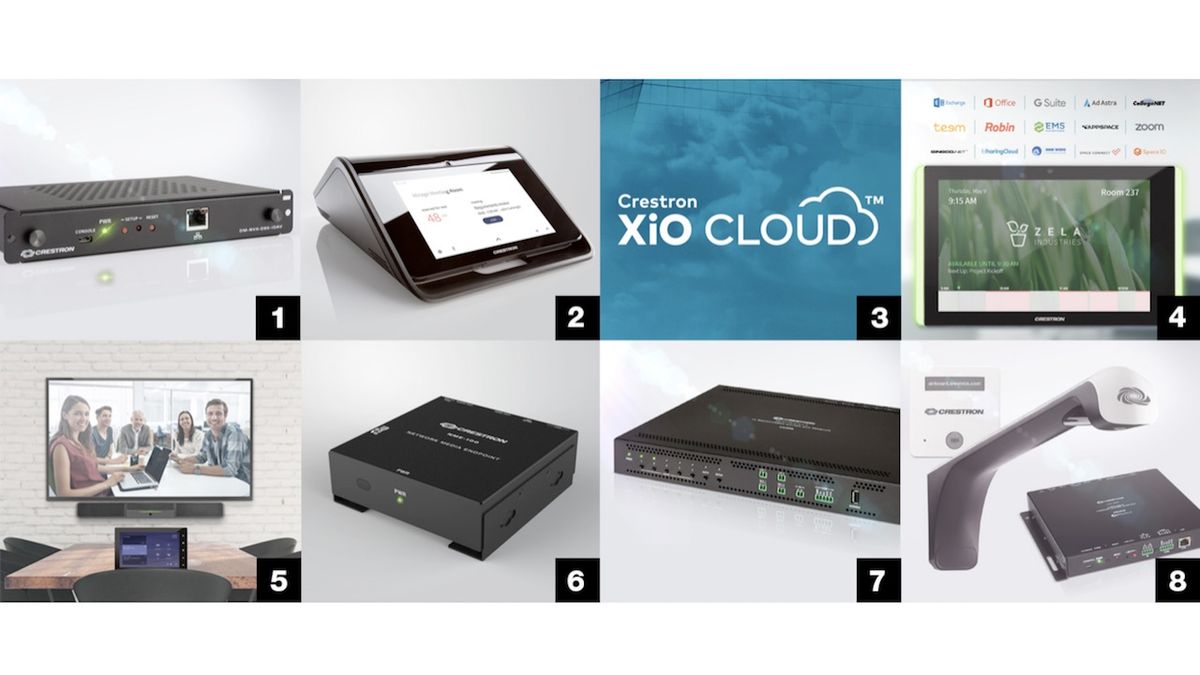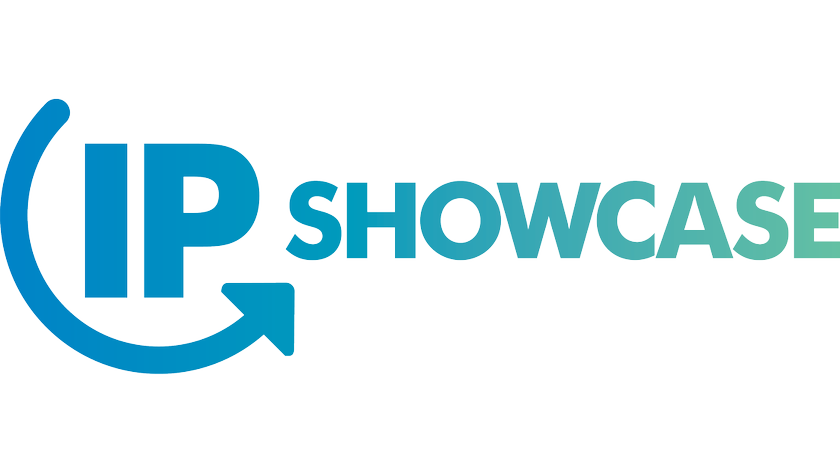A couple of weeks before InfoComm, the press was invited to Crestron’s headquarters in Rockleigh, NJ, to gain insight from product managers and team members on significant announcements. We’re highlighting eight announcements below in random order. They are numbered only to correspond with the product collage and not order of importance.
1: Crestron DM-NVX-D80-IoAV Connects Displays to the AV-over-IP World
Crestron is debuting its DM-NVX-D80-IoAV at InfoComm 2019. Crestron worked with Intel to deliver a native network AV solution for some of the biggest display manufacturers: LG, NEC, Philips, Avocor, and Smart. The OPS- (Open Pluggable Specification) based DM NVX network decoder can instantly transform a display into a native DM NVX endpoint. The DM-NVX-D80-IoAV is a plug-and-play solution that enables displays to deliver audio and 4K video across any network.
“Working with top talent at Intel, we created a 1Gb, 4K/60, AV-over-IP solution based on Intel’s open standard OPS slot,” said Fred Bargetzi, Crestron CTO. “The DM-NVX-D80-IoAV drops into native OPS slots in the back of professional displays, adding enterprise-grade security and Crestron XIO Cloud management and provisioning based on Microsoft Azure technology.”
“The D80 is all about connecting display manufacturers to AV over IP and DM-NVX,” said Crestron’s DigitalMedia technology manager, Alex Peras.
Interoperability and flexibility were the key drivers in the design of the DM-NVX-D80-IoAV. The variety of OPS-supported displays allows for tailor-made solutions that fit nearly any application. In addition, the form factor of the allows displays to be flush-mounted to the wall.
The DM NVX network AV is a complete, infinitely scalable solution that also transports audio, USB, and control. With the new Pixel Perfect Processing technology, DM NVX delivers a clear image every time over any network (1Gb, 2.5Gb, 5Gb, and 10Gb).
This technology also allows for integration with Crestron XiO Cloud, an IOT-based platform that enables system deployment without programming with the ability to monitor, manage, and control each display from one centralized location.
2: Crestron Mercury X and Enhanced UX on all Mercury Models
Having listened to a lot of feedback from end users and customers about what Crestron can do to evolve the Flex platform, Joe Sarrasin, technology manager, unified communications at Crestron said, “We’ve taken that to heart, and we'll be debuting what we're calling Mercury X, which features two big advancements for us.” One advancement is the flexibility to run native software, including Microsoft Teams and Zoom Rooms, and the ability to switch to a BYOD on the same device.
Second is Crestron’s response to requests for a simple “one cable-to-table” connection and a cleaner, simpler user experience. “You have the regular presentation with HDMI like we've had the whole time, but now there will be another USB cable available,” Sarrasin said. “When you plug the USB cable in, you can take away the camera and the audio device from the room system and use it with your laptop.
“On a more practical level, a lot of our integration partners are very excited about having to just pull the Cat cable between that device and the front of the room. It really simplifies the installation of the wiring.”
Crestron Mercury X, and all Crestron Mercury models, will also feature a more modern UI for a simpler user experience.
3: Evolution of Crestron XiO Cloud
The latest version of XiO Cloud, Crestron’s IoT-based technology provisioning and management solution further empowers technology managers with remote support for touchscreens, support for a growing portfolio of third-party devices, and an API to pull intelligence data. Crestron is also introducing a Developer Kit.
“The new features and developer tools, plus support for even more devices, speaks to our commitment to support technology managers by evolving the Crestron XiO Cloud platform—and without requiring any additional infrastructure investment,” said Brian Donlan, Crestron technology manager, enterprise software.
Crestron XiO Cloud now enables managers to remotely view and control Crestron touchscreens (TSW and TSS), making technical support faster and simpler. A new API enables managers to pull data by connecting Crestron XiO Cloud to business intelligence platforms via cloud-to-cloud connections, and the new Developer Kit enables third-party technology manufacturers to integrate their devices with Crestron XiO Cloud, so they can be managed like Crestron devices.
4: Expanded Room Scheduling Platform
Extending what was already a broad range of supported third-party scheduling software, Crestron is debuting the latest additions to its family of room scheduling platform.
Ad Astra, CollegeNET, New Wave Apps, and SpaceIQ now run on Crestron room scheduling touchscreens. “Now that the third-party scheduling software is direct and native, they all have the exact same appearance and deliver the same user experience,” said Julian Fernandez, program group marketing manager at Crestron. “In the back-end they're actually controlling different databases. It’s all about providing organizations with the ability to decouple the scheduling hardware from the software application.”
Crestron is also debuting the latest additions to its family of room scheduling touchpanels with the TSW-560 and TSW-560P, both of which support direct connect scheduling.
5: Crestron Flex M-Series and B-Series Single Display Kits
Crestron Flex Unified Communications Platform adds functionality and options with its new M-Series and B-Series single display kits. These were designed to address market demand for greater access to a native Microsoft Teams experience in a wider range of spaces, and greater demand for the consistent simple user experience Crestron Flex affords.
The continued expansion of certified Microsoft Teams devices reflects the deepening relationship between Crestron and Microsoft, and the commitment to provide the full Microsoft Teams experience to any meeting space affordably, consistently, and securely. With these single-display options, more businesses can access the Microsoft Teams experience in more spaces.
Heading into InfoComm Joseph Sarrasin said that beyond having the full line of products, he is really excited that, “We're part of the GPA Velocity program, [Global Partner Alliance Velocity Program, which is Whitlock is a founding partner]. What's nice is that we now see our integration partners coming on board with the idea of an all-in-one solution they can sell as a packaged solution for global company.”
The Crestron Flex M-Series MX models combine BYOD connectivity and a native Microsoft Teams experience, providing users with multiple ways to collaborate within their space.
Crestron Flex M-Series, B-Series, and C-Series room systems also integrate seamlessly with Crestron AirMedia 2.0.
6: Network Media Endpoint (NME-100), Digital Signage and Media Player
Crestron is debuting its new Network Media Endpoint (NME-100), a device that enables organizations to deliver consistent communications enterprise-wide via digital signage and media playback. Combined with in-room signage solutions, including AirMedia 2.0 presentation systems and the Crestron Mercury tabletop meeting and collaboration systems, Crestron has signage needs covered for nearly every enterprise space.
“Until now, we offered only ‘light’ signage solutions in the form of Crestron Mercury and AirMedia products integrated with Appspace,” said Nic Milani, executive director, commercial product marketing at Crestron. “These solutions are great for ambient signage, when the room display is inactive. Now, with the NME-100, we offer a robust solution that makes it easy to add live and interactive content to a full range of spaces using powerful Appspace software.”
The NME-100 is designed to eliminate the need for programming and is ready to use right out of the box, with provisioning and management from the cloud using the Crestron XiO Cloud. The NME-100 will be released with Appspace integration to take advantage of its digital signage content creation, management, and interactive playback capabilities.
7: Expanded DM Lite Product Line
Crestron is showcasing its expanded DM Lite endpoint product line, including the new HD-RX-4K-510-C-E and HD-RX-4K-410-C-E receivers. Both models provide auto-switching, amplified audio outputs for speakers, and network connectivity for management and setup.
“For smaller rooms, the product line allows you to take transmitters and receivers and then put a single one of these DM Lite receivers behind the display or up on a pole or in a rack,” said Alex Peras. “They're really small devices.”
You can mix and match for whatever room configuration you need. “For instance, you could select the two-gang transmitter, one-gang transmitter, or individual transmitters that could sit underneath the table or on a podium,” Peras said. “It's very versatile how it can be used.”
Pair any DM Lite receiver with a Crestron MPC3 media presentation controller to add low-cost room control. Engraveable buttons and dials on the MPC3 can be configured with the built-in .AV Framework software. The system can be provisioned, monitored, and managed using any web browser via the Crestron XiO Cloud IoT-based provisioning system.
8: AirMedia 2.0 Wireless Presentation Systems and Upgrade Offer
The enhancements to AirMedia 2.0 are significant. “It is a totally different platform than the 100, 101 that we started with, which was based on somebody else's chipset,” said Nic Milani.
The AirMedia 2.0 Wireless Presentation Systems (AM-200, AM-300) feature a simpler user interface, quick connection via all operating systems, and native integration with the Crestron AirBoard whiteboard capture system and Crestron Flex UC solutions.
“Using page flip, now you can use AirMedia and inject wireless content into a team's experience” Milani said.
The AV industry mantra continues to be a consistent user experience from room to room. “There has been a customer demand for consistency across the board,” said Joseph Sarrasin. “We can be that bridge that lets you take in these kind of diverse presentation formats natively into these UC systems.”
AirMedia already supported Chrome, and this summer Miracast will be added. This will have a significant impact, according to Milani. With Miracast, guests can directly connect to a guest network via Wi-Fi without creating a security risk to the corporate network.
“AirMedia 2.0 will support all the formats, all the devices, and then plug into all the different gear that we sell,” Milani said. “That's a big change.”
For a limited time, Crestron is offering customers the opportunity to trade in existing AirMedia AM-100 and AM-101 units and get the AM-200 at 70 percent off MSRP.













